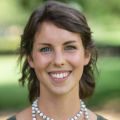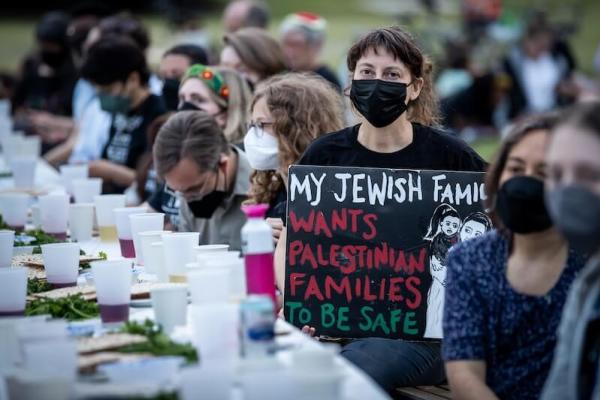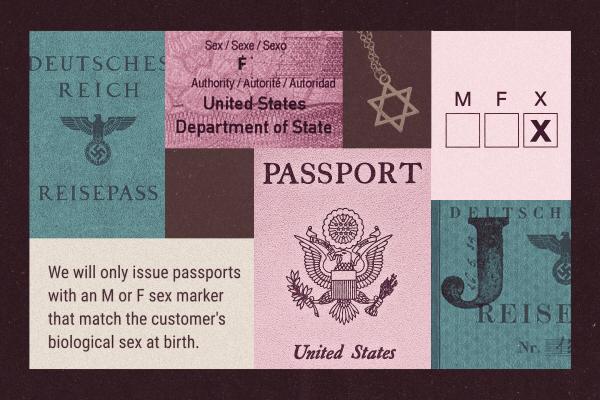Indistinct chatter swells from auditorium seats and large speakers thump contemporary bass beats. A smooth transition brings jazzy brass from decades’ past and finally, a warbling voice practically anyone, even the middle school-aged audience, recognizes; they pause to listen.
“And I got to the point that I couldn’t take it any longer; I was weak. … And it seemed at that moment that I could hear an inner voice saying to me, ‘Martin Luther, stand up for righteousness, stand up for justice, stand up for truth. And lo I will be with you, even until the end of the world.’”
–Dr. Martin Luther King, “Why Jesus Called a Man a Fool,” sermon delivered at Mount Pisgah Missionary Baptist Church, 1967
Dr. Martin Luther King received two calls one midnight. A voice on the telephone threatened his life and his family’s. A voice from inside encouraged him to take heart and press on. Dr. King listened to one and ignored the other; his response led him into a life story chronicled in history books and spread across the world.
School shootings and racial injustices today echo the fevered pitch of the 1960s. Today’s violence, intolerance, and isolationism is apparent to young people who are at a time in their lives when they learn either to despair and ride the wave down, or build strong character while positively impacting their communities. The latter is the message a group of musicians from Denver, Colo. are promoting in schools locally, nationally, and globally.
More Than Music, a nonprofit music missionary organization, created At The Table With Dr. King, a multi-media presentation that uses Dr. King’s story to inspire culture change in schools.
39909757131_00ce84b51a_o_1.jpg
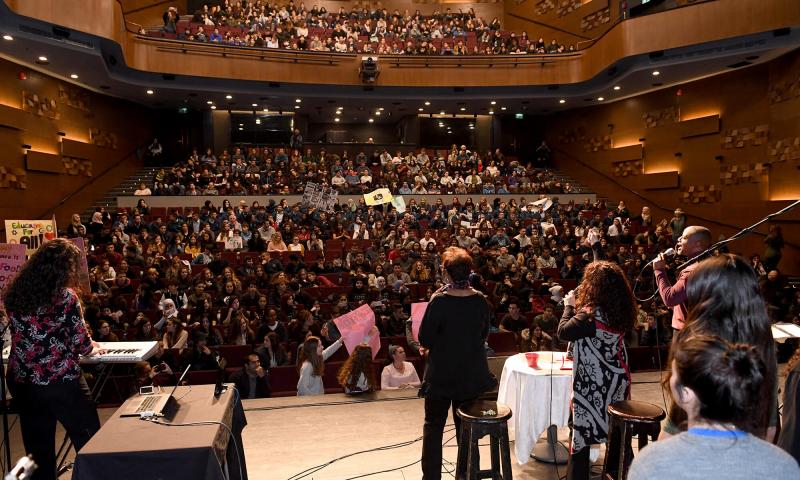
The musicians, a group of 50 touring artists from Colorado, Tennessee, and California, have put on the show 335 times for a total of nearly 200,000 students in the past ten years. They’ve performed in 19 U.S. states, India, Dubai, and Israel.
Most of the students, elementary to college-aged, know Dr. King’s narrative on a textual level. Educators who’ve seen At The Table say the social justice implications of his life and how they connect with kids today might be lost in the pages. History comes alive and gains new meaning when it marches into school gymnasiums and theaters, wheeling lights, a projector screen, drum set, and antique organ.
To live and learn with music
They’re kids. Hundreds of them told to pay attention, not to slouch, keep their eyes forward and hands to themselves. It’s school.
And then jazz enters the scene, a music that grapples with chaos and comes out with soul. In the tension of clashing notes and melodies, fingers flying across valves and keys, the band finds a groove that communicates the experience of the civil rights movement.
Choir member Michelle Pulley, donning a full robe and stole, belts out vocal runs in the assembly’s first big musical number, “At The Table,” by Richard Smallwood.
“It’s just a way to further drive home a message,” she said. “I’m so thankful to have these different vocal techniques to help people connect more with a situation, especially this situation with Dr. King and the civil rights era.”
Katesha Campbell, another vocalist, added, “Sometimes you teach at their level, but then you also teach up to give them something to reach up to.”
Between “This Little Light of Mine” and “Lean on Me,” and videos about Dr. King’s legacy, At The Table musicians take the microphone to speak directly into the audience members’ lives — and it’s not a simple “You can be who you want, just do it.” kind of motivational speech.
The performance’s central teaching is about the definition of calling, a definition, said saxophonist Chris Lang, that happens to be an obviously Biblical truth: “Pay attention — pay attention to what you’re good at and passionate about, but also pay attention to how you can use it to help others.”
In all the shows More Than Music has done, according to Lang, nobody has complained about the show’s overtly spiritual music. “I think God has placed that kind of vacuum in every one of us to desire Him, and it’s only fulfilled by Him,” Lang said. “So whenever we present His truth to somebody — in a way that they don’t put up their defense… they just receive that truth.”
Creative director of More Than Music Dave LeMieux incarnates the art and mission of his ministry. He easily embraces people, figuratively and literally. His singing voice is strong and smooth with the assurance that his work is his calling.
It started in 1999 with the Columbine High School shooting. LeMieux asked God how he could enter schools with gospel-driven messages — ideas that would capture kids’ attentions and reverse negative contemplations.
He stored this prayer for a decade. Meanwhile, he worked with musicians at Colorado Community Church, created a Dr. Martin Luther King celebration at the City of Aurora’s request, and formed his band, Dave LeMieux & House of Soul, which led to the More Than Music nonprofit in 2009. Finally, the original Dr. King show was rewritten to meet students’ needs. Columbine felt like a watershed moment, LeMieux said, and now it’s sadly a regular event creating a necessary mission field.
During the show, he recaps one of the most well known moments in Dr. King’s leadership: when the pastor stood at Washington’s National Mall. As King spoke, he heeded a call from his friend, Mahalia Jackson: “Tell them about the dream, Martin!”
“Thank goodness for our friends that call us into action,” LeMieux said.
Call and response is a key principle on which jazz/blues and the civil rights movement are all built. And so the students join a recreation of the March on Washington around the room.
A final urge to the audience to realize their own dreams and also touch others’ dreams brings the performance home, culminating in the final number, “I’ll Take You There,” by The Staple Singers. The gospel sung in a bopping blues key, with long moans and brass bleats, compels some kids to get up and groove. After looking around a bit self-consciously, more join in the bounce and sway, waving phones and cheering.
Returning to the halls
Reduction in school violence is a major goal, though the music team may not personally witness that vision fulfilled.
As a nonprofit, partially grant-funded organization, however, they need to prove some measure of efficacy. According to last year’s report, 28 schools across the nation have completed return visits. The 2019 school year already has six schools booked; half of those being repeat invitations.
“The show was extremely impactful for our students and they created affinity groups and assemblies inspired by the show,” said Imana Legette, former Diversity Coordinator for Charlotte Country Day School in Charlotte, N.C.
39199102564_971440008d_o_1.jpg
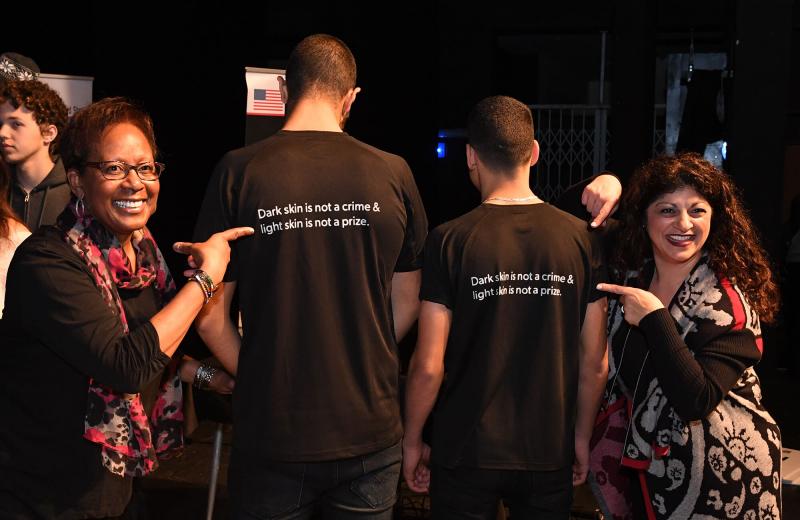
Educators’ survey responses attest to changes in their students’ attitudes toward activism, protests, volunteering, and engaging in uncomfortable discussions.
Each performance takes into account the particular needs of the host school. LeMieux and logistics director/organist Kaitlin McCarthy communicate with administrators beforehand about specific challenges, potential items to edit into the show’s dialogue. Depending on the musicians’ availability, a school can book a whole day with More Than Music that includes the assembly and workshops covering topics such as the role of music in civil protest, ethics discussions on contemporary issues, and musical performance/technique. The Mizel Museum, co-producer of the production with More Than Music, provides teacher resources and lesson plans for further instruction on social change, civil disobedience, disenfranchisement, rhetoric, and advocacy.
Influencing the way kids step up in their lives and communities is a huge endeavor. At The Table with Dr. King is a brief moment in the process.
“We don’t try to over inflate or overestimate what our impact can be,” Lang said. “We’re only there for an hour out of the whole school year. We know the greater impact is the teachers, the administrators, the culture at that school.”
Schools with enthusiastic leaders and a diverse population are the most harmonious with At The Table. Aurora Hills Middle School in the city east of Denver is a favorite among the musicians. The students engage with the rhythms of the performance and, better yet, are ethnically and socioeconomically diverse — exactly the sort of thing Dr. King was looking for, a fulfillment.
Aurora Hills, an International Baccalaureate school, flies 39 flags in its cafeteria; each is from a country represented by the students, some of whom speak up to five languages, according to Roy Smith, the Aurora Public Schools Family Liaison. The area is home to a number of displaced people.
39877078722_6f6237f10a_o_1_1.jpg
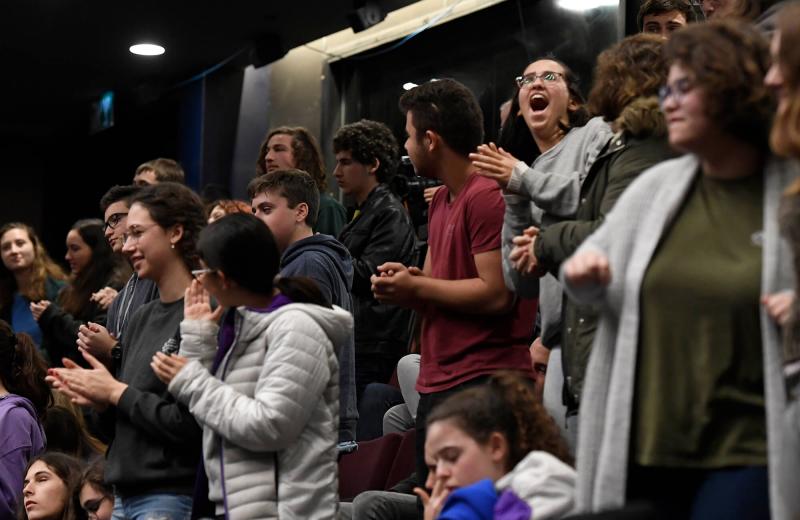
Large white trash bags filled with backpacks, notebooks, paper, pens and pencils — all a kid needs to learn, crowds Smith’s office. About half of the AHMS student body takes these “treasures.” To the left, a bookshelf features family photos, resource binders, and mottos, including a reminder from Rosa Parks: “Each person must live their life as a model for others. Memories of our lives, of our works and our deeds will continue in others.”
For Smith, social justice means justice for everybody. In his work that means pulling together food, clothes, lawyers, medical care — anything that will help a child and their family be successful.
Smith said a lot of kids know injustice from experience or watching it on TV, but they don’t know the ins and outs of social justice. He thinks they can connect with At The Table with Dr. King, using it as a gateway to history and a personal inspiration. If they need a reminder, Smith will give his own example being motivated by Dr. King’s legacy.
“I’d go by it every day!” he said.
“Yeah… yep, yep, yep. And I share that with the students a lot. That I went to school around the corner from where Martin Luther King lived. … So, not only did I know the impact, I’ve seen the impact. I was there in Atlanta in 1964 and ’65 …”
Rosalia Lotspeich, an art teacher at Aurora Hills, saw the performance two years ago when At The Table first came to the school. She responded to the performance by developing a curriculum unit about Dr. King’s message and other role models in art and music who fight for diversity.
“We’ve come so far but we have so much further to go, and I feel that the kids in our school thrive on music and art because it gives them that voice that they’re able to use,” Lotspeich said.
She helps lead the No Place For Hate initiative at AHMS, a club with curriculum designed by the Anti-Defamation League. She says At the Table complements their efforts.
Listen. Live. Repeat.
Musician, novelist, and essayist Ralph Ellison wrote that jazz could send you “into an ecstasy of rhythm and memory and brassy affirmation of the goodness of being alive and part of the community.”
At The Table with Dr. King uses 1960s music and the leader’s legacy to a similar effect, with an intended paradigm shift in kids’ perception of being alive and in community.
This year, the 50th anniversary of Dr. King’s death, could have been a stopping point for the show. As long as Dr. King’s story is recognized and desired, and as long as God calls for this work, Lang said he’d keep responding. There’s no end to the joy of seeing jazz and social action resonate with students.
Got something to say about what you're reading? We value your feedback!

